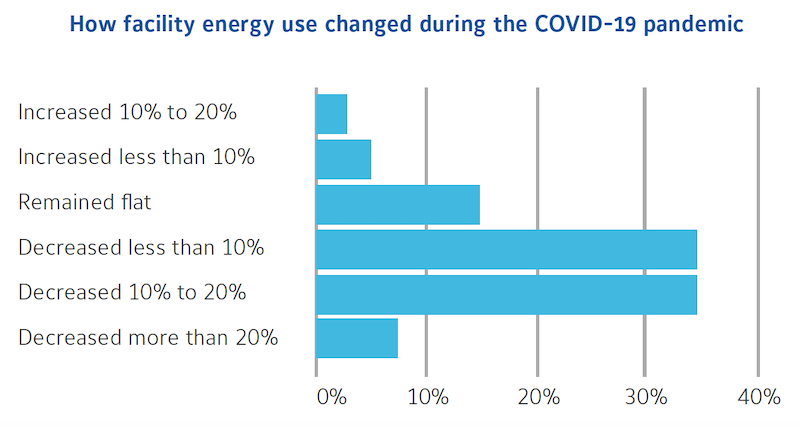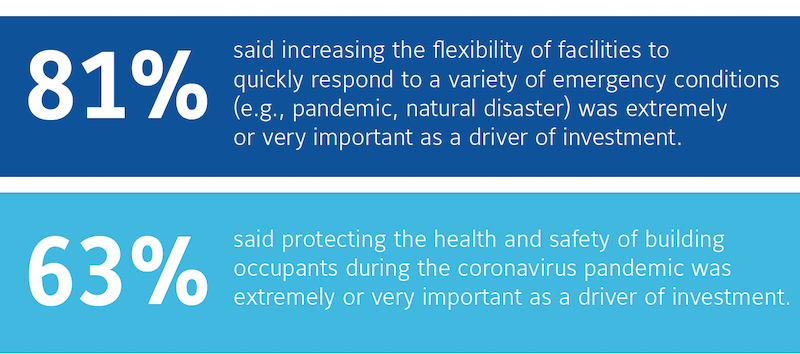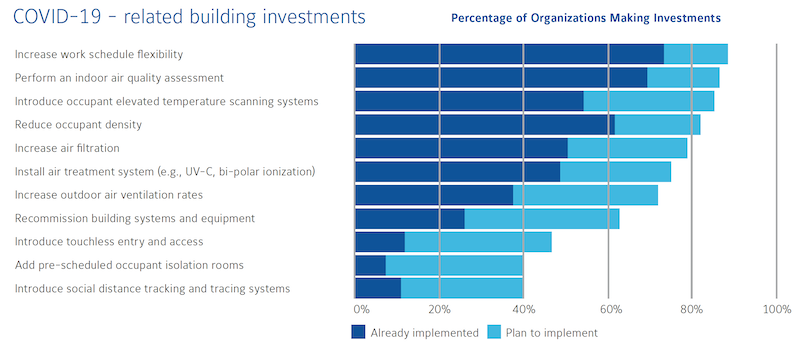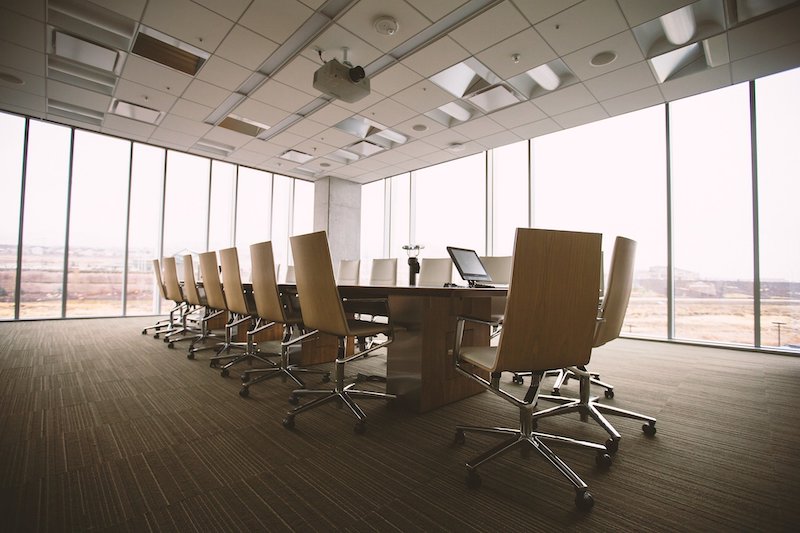During a recent investor and analyst conference call, George Oliver, chairman and CEO of Johnson Controls, revealed that his company is looking at potential building air-system upgrade projects valued at “a couple of hundred million” dollars in just the next year. Bloomberg reported that Honeywell International has more than $600 million worth of projects in its pipelines. Carrier Global Corp. estimates that the market for indoor-air quality improvements in buildings could eventually reach $10 billion.
However, these improvements won’t necessarily make buildings more energy efficient. Carbon Lighthouse, the energy savings as a service provider, recently surveyed its clients about how they were managing their buildings’ energy use during a pandemic that forced many employees to work remotely from home, leaving many buildings largely empty.
That poll found three-fifths of the clients’ building portfolios had lowered their energy consumptions by an average of only 23% (compared to an 80% average decline in occupancy most buildings experienced). In one-quarter of the clients’ buildings, there was no change in energy use during shelter-in-place.
These findings bring into sharp relief how COVID-19 has created a massive headwind against energy conservation and continues to pose a significant environmental challenge as building operators focus on HVAC upgrades and air-quality solutions. What’s more, some operators may be under the misconception that if buildings are empty, energy efficiency no longer needs to be a priority.
OCCUPANCY AND ENERGY USE DISCONNECT
Corroborating that assessment is Johnson Controls’ latest Energy Efficiency Indicator COVID-19 Pulse study, based on its survey last September of 150 commercial, institutional, and industrial facilities executives in the U.S. This survey included questions on coronavirus-related improvements, investments, and impacts.

Few buildings altered their energy usage commensurate with reductions in their occupants. Image: Johnson Controls
Perhaps the most sobering finding in Johnson Controls’ study is that the virus had not substantively reduced building energy consumption, regardless of reduced occupancy rates. During the pandemic, less than 10% of the organizations surveyed reduced their energy use by more than 20%. More typical were buildings that decreased their energy consumption by between 0-20%. More than 7% of the surveyed companies increased their energy use.
There could be several reasons for this, explains Clay Nesler, Johnson Controls' Vice President of Global Sustainability. “Even buildings in New York City, where occupancy can be at around 10%, space is still being leased with service agreements that require buildings to maintain temperatures.” Nesler also points out that, typically, more than 50% of a building's energy load is under its tenants' control. “How many refrigerators, computers, and monitors are still plugged in? What's going on with the lights?” He adds that many tenants have big data closets, “and those IT loads aren't going down.”
e
Making environments safer quickly during a health event is where facilities managers say investment dollars are flowing. Image: Johnson Controls.
Most facilities managers saw a more pressing need for flexibility that can quickly respond to emergency conditions. There was a significant increase, compared to last year, of facilities managers who view occupant safety as a critical driver of investment. Another important driver, said 85% of those polled, was energy cost savings.
DID SOMEONE SAY ‘TOUCHLESS’?

Improving indoor air quality is one of facilities managers' investment priorities. Image: Johnson Controls
When it came to actions in response to the virus’ spread, 60% of the survey’s participants said that plan to upgrade their HVAC and air filtration systems More than half had already conducted air-quality assessments, introduced elevated temperature scanning systems, and increased air filtration.
Nearly 90% of those polled by Johnson Controls said they had already implemented or planned to expand their employees’ work schedule flexibility. But there was less interest in such infection-control measures as introducing touchless entry and access, adding pre-scheduled occupant isolation rooms, or installed systems that track and trace social distancing.
Johnson Controls' Nesler acknowledges that energy efficiency can sometimes confliect with health and safe measures. But it doesn't have to be that way. He points specifically to Environmental, Social, and Governance assessments of sustainable buildings, conducted by the benchmarking firm GRESB, that found these buildings better able to regulate their energy uses, partly by giving tenants solutions to do so before an event hits.
“We believe the future is in control systems that go beyond “on” and “off” to include a pandemic mode” that would align with CDC and ASHRAE safety regulations, says Nesler. He adds that there might also be anther control for facilities managers that allow them to shut down a building's non-critical loads. “We think resilience will be a big thing going forward.”
Editor's note: Information from Clay Nesler of Johnson Controls was added to this story after its initial posting.
Related Stories
| Oct 11, 2010
Rhode Island is the first state to adopt IGCC
Rhode Island is the first state to adopt the International Green Construction Code (IGCC). The Rhode Island Green Buildings Act identifies the IGCC as an equivalent standard in compliance with requirements that all public agency major facility projects be designed and constructed as green buildings. The Rules and Regulations to implement the Act take effect in October 2010.
| Oct 8, 2010
Union Bank’S San Diego HQ awarded LEED Gold
Union Bank’s San Diego headquarters building located at 530 B Street has been awarded LEED Gold certification from the Green Building Certification Institute under the standards established by the U.S. Green Building Council. Gold status was awarded to six buildings across the United States in the most recent certification and Union Bank’s San Diego headquarters building is one of only two in California.
| Oct 6, 2010
Windows Keep Green Goals in View
The DOE's National Renewable Energy Laboratory has almost 600 window openings, and yet it's targeting LEED Platinum, net-zero energy use, and 50% improvement over ASHRAE 90.1. How the window ‘problem’ is part of the solution.
| Oct 6, 2010
From grocery store to culinary school
A former West Philadelphia supermarket is moving up the food chain, transitioning from grocery store to the Center for Culinary Enterprise, a business culinary training school.
| Sep 30, 2010
Luxury hotels lead industry in green accommodations
Results from the American Hotel & Lodging Association’s 2010 Lodging Survey showed that luxury and upper-upscale hotels are most likely to feature green amenities and earn green certifications. Results were tallied from 8,800 respondents, for a very respectable 18% response rate. Questions focused on 14 green-related categories, including allergy-free rooms, water-saving programs, energy management systems, recycling programs, green certification, and green renovation.
| Sep 16, 2010
Green recreation/wellness center targets physical, environmental health
The 151,000-sf recreation and wellness center at California State University’s Sacramento campus, called the WELL (for “wellness, education, leisure, lifestyle”), has a fitness center, café, indoor track, gymnasium, racquetball courts, educational and counseling space, the largest rock climbing wall in the CSU system.
| Sep 13, 2010
Second Time Around
A Building Team preserves the historic facade of a Broadway theater en route to creating the first green playhouse on the Great White Way.
| Sep 13, 2010
World's busiest land port also to be its greenest
A larger, more efficient, and supergreen border crossing facility is planned for the San Ysidro (Calif.) Port of Entry to better handle the more than 100,000 people who cross the U.S.-Mexico border there each day.
| Sep 13, 2010
'A Model for the Entire Industry'
How a university and its Building Team forged a relationship with 'the toughest building authority in the country' to bring a replacement hospital in early and under budget.













